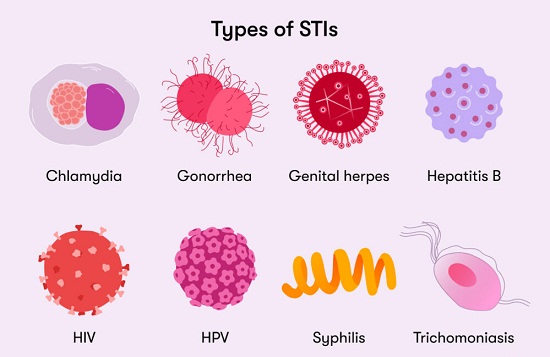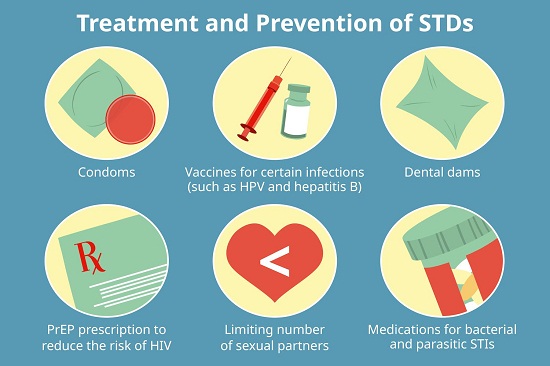Sexually transmitted diseases (STDs), also known as sexually transmitted infections (STIs), are very common infections. According to the World Health Organisation (WHO), ‘More than 1 million curable sexually transmitted infections (STIs) are acquired every day worldwide in people 15–49 years old, the majority of which are asymptomatic.’
How do Sexually Transmitted Diseases spread?
STDs are spread by by sexual contact , mainly by penetrative sexual intercourse. But they may also spread by oral or anal sex. Some can also spread by kissing or by touching the genitals.
Sometimes, sexually transmitted infections can be spread by ways other than sexual contact. For example, they can spread from a mother to an infant during pregnancy or childbirth. They can also spread through blood transfusions or by shared needles.

What is the difference between STDs(sexually transmitted diseases) and STIs (sexually transmitted infections)?
Although the causes, symptoms and treatments are the same, STDs and STIs are not the same. An STI (an infection) leads to the occurance of an STD (a disease with symptoms). An STI may not cause any symptoms. Once symptoms or complications occur, it becomes a disease.
Why do STDs occur? What is the cause?
STDs can be caused by infections due to bacteria, viruses, parasites, or fungi.
The most common ones are chlamydia, gonorrhoea, syphilis and trichomoniasis. While chlamydia, gonorrhoea, syphilis are casued by bacterias, Trichomoniqasis is caused by parasite..
- Bacteria: Chlamydia, gonorrhea, and syphilis.
- Viruses: Human immunodeficiency virus (HIV), human papillomavirus (HPV), herpes simplex virus (HSV), and hepatitis B and C.
- Parasites: Trichomoniasis.
- Fungi: Yeast infections, although not typically classified as STDs, can sometimes be transmitted sexually.
These pathogens can be spread through vaginal, anal, or oral sex. Some STDs, such as Herpes and HPV, can be transmitted through skin-to-skin contact.
Types of STDs
There are different sexually transmitted diseases, each with different signs and symptoms:
- Chlamydia: Chlamydia is a bacterial infection that often causes no symptoms. But it can cause infertility or subfertility if left untreated.
- Gonorrhea: Gonorrhea is another bacterial STD that can affect the genitals, rectum, and throat.
- Syphilis: Syphilis is a bacterial infection that usually starts in the genitals or mouth. It then progress in stages to the blood and then affects the nervous system.
- HIV/AIDS: A viral infection that attacks the immune system, HIV suppresses the immune system, making it difficult to fight off other infections.
- HPV: A viral infection by Human Papilloma Virus, it can cause genital warts and is linked to cervical and other cancers.
- Herpes: Herpes Genitalis is a viral infection causing painful blisters and sores on the genitals and mouth.
- Trichomoniasis: This is a parasitic infection caused by infection with a parasite called Trichomonas Vaginalis. It causes greenish, frothy vaginal or urethral discharge and severe itching.
- Hepatitis B and C: Viral infections affecting the liver, which can be transmitted sexually.

What are the symptoms of STDs?
The symptoms of STDs depends on the type of infection. Some people may not get any symptoms at all. Symptoms are mainly present on the genital region but may also occur in other body systems. Common symptoms include:
Genital Symptoms:
- Discharge from the vagina or penis which is of a unusual odor or color.
- Open sores or ulcers n the genital area, rectal area or in the mouth ad throat. HSV causes very painful ulcers or blisters. But Syphilis and Chlamydia generally causes painless ulcers.
- Bumps, or blisters on the genitals or anus
- Itching or irritation – Trichomoniasis generally causes severe itching
- Painful and/or swollen testes.
Systemic Symptoms:
- Fever with sore throat
- Fatigue,
- General ill health
- Muscle pain
- Swollen lymph nodes.
- Sore throat.
Urinary Symptoms:
- Painful or burning sensation during urination.
- Discharge from the urethra
- Itching
Other Symptoms:
- Pain during sex
- Unusual bleeding or spotting,
- Abdominal pain.
- Nausea and diarrhea
- Weight loss
- Rash over the trunk, hands or feet.
How are STDs Diagnosed?
STDs are mainly diagnosed by laboratory tests. But the signs and symptoms which differentiate between the different STDs are identified by clinical history and examination
Medical History and Physical Exam: You will be asked about your symptoms and the duration of the symptoms. You will also be asked about your sexual history, about any incidence of unprotected sexual intercourse and whether your partner was known to have a STD.
Physical Examination: A physical examination is necessary to identify any ulcers, sores or blisters in the genital region. Vaginal or penile discharge, pain and inflammation in the area and presence of lumps are other important physical features.
Laboratory Tests: Samples of blood, urine, or genital fluids may be taken to test for specific STDs. Swabs from the throat, rectum, or affected areas may also be used.
Imaging Tests: In some cases, imaging tests like ultrasounds may be necessary. Ultrasounds typically check the abdomen for any complications from STDs like PID. PID may cause fluid to collect in the Pouch of Douglas behind the uterus.
What are the Risk Factors for STDs?
There are some risk factors which may increase the incidence of STD.
- Multiple Sexual Partners: Having multiple partners increases your risk of exposure to STDs.
- Unprotected Sex: Not using condoms or dental dams during sex significantly raises the risk of contracting an STD.
- Age: Younger people, particularly those aged 15-24, are at higher risk.
- Substance Abuse: Alcohol and drug use can impair judgment and lead to risky sexual behavior.
- Tattoos: Infections can occur with tattoos made using unsterilized needles or piercings
- History of STDs: Having an STD once increases the risk of getting another.
- Certain Medical Conditions: Conditions that affect your immune system can increase susceptibility to infections. A low immune system can increase the risks of getting an STD.
How are STDs treated?
The treatment for STDs depends on the type of infection:
- Bacterial STDs: These are typically treated with antibiotics. It’s crucial to complete the full course of medication even if symptoms disappear.
- Viral STDs: While many viral STDs can’t be cured, antiviral medications can help manage symptoms and reduce the risk of transmission. For example, anti-retroviral therapy (ART) is used to manage HIV.
- Parasitic Infections: These are usually treated with prescribed oral or topical medications.
- Fungal Infections: Antifungal creams or medications are used to treat infections caused by fungi.
How can STDs be prevented?
Preventing STDs is essential for maintaining sexual health. Some ways by which you can protect yourself are:
- Use Protection: Consistently using condoms or dental dams during sex can significantly reduce the risk of STD transmission.
- Get Vaccinated: Vaccines are available for some STDs, such as HPV and hepatitis B.
- Regular Testing: Regular screening helps detect STDs early, even if you don’t have symptoms. Early detection allows for prompt treatment and reduces the risk of complications.
- Monogamous Relationships: Being in a mutually monogamous relationship with a partner who has tested negative for STDs can lower your risk.
- Communication: Open and honest communication with your partner about sexual health and STD testing is crucial.
- Avoiding Substance Abuse: Steering clear of drugs and alcohol can help you make safer sexual decisions.

Can complications occur?
Untreated STDs can lead to serious health complications:
- Reproductive Health Issues: STDs like chlamydia and gonorrhea can infect the internal female organs to cause cause pelvic inflammatory disease (PID), leading to infertility and ectopic pregnancies.
- Chronic Pain: Infections can result in chronic pelvic pain.
- HIV infection cause AIDS, a serious immune disease.
- Increased Risk of HIV: Having any STD increases your susceptibility to HIV.
- Newborn Health Issues: Pregnant women with STDs can transmit the infection to their babies while in the uterus or during childbirth, causing serious health problems for the infant.
- Cancer: Certain types of HPV are linked to cervical, anal, and throat cancers.
Read More Questions and Answers on Pregnancy and Gynecology
Natural PCOS Solutions: Control Symptoms, Manage Irregular Periods, and Reduce Excessive Hair Growth
Tackling PCOS Symptoms: A Patient’s Journey with Dr. Madhumita Mazumdar Polycystic Ovary Syndrome (PCOS) is a common hormonal disorder that can significantly impact young women’s

Early Pregnancy Bleeding: Causes, Symptoms and Treatment
Early Pregnancy Bleeding can be due to benign causes like implantation bleeding or due to serious causes like miscarriage or ectopic pregnancy.

HPV: 10 Important Facts
Human papillomavirus (HPV) is a sexually transmitted infection (STI) that can cause warts and cancers. There are more than 100 strains of HPV, some more dangerous than the others.

Ovulation Bleeding: Symptoms, Causes and Treatment
Ovulation bleeding, also known as mid-cycle bleeding occurs at around the 14th day of the menstrual cycle.

Abdomen Pain in Early Pregnancy: Causes and Treatment
Pain in the abdomen is common in early pregnancy. These can be due to benign causes like UTI or intestinal gas. But miscarriage needs to be ruled out.

Uterine Fibroids: A Patient’s Journey to Diagnosis and Treatment
Uterine fibroids, also called ‘Myomas’, are non-cancerous growths that develop in the muscles of the uterus, affecting many women during their reproductive…



